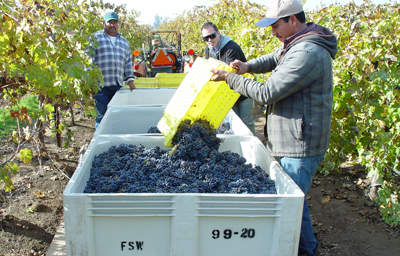California Agricultural Technology Institute
Color enhancing strategies
Viticulture trials seek to establish best practices in the use of ABA to enhance color in red wine grapes
In the housing market, it s location, location, location, they say. In the wine market, is it color, color, color? That may be up for debate, but color is certainly a major factor consumers consider when evaluating a red wine for purchase, notes Fresno State viticulture research specialist and professor Sanliang Gu.
That s why Gu is working to show San Joaquin Valley wine grape growers new ways to enhance the color of the fruit they produce.

Reporting on several years of trials on Fresno State s University Farm Laboratory vineyards and at other commercial sites, Gu has outlined protocols for applying a compound called abscisic acid (ABA) on red wine grapes to enhance coloration as they ripen for harvest.
Detrimental high temperatures in warmer regions of grape production, such as California s San Joaquin Valley, often inhibit accumulation of pigments and color development during ripening of certain varieties, Gu said.
ABA has been shown in prior research to be effective in enhancing red wine grape color, he noted. However, high production costs for ABA in the past have made it cost-prohibitive for most growers.
That has changed in recent years. Advances in production methods have reduced retail prices, making ABA a more attractive option.
The critical challenge now is to research application methods to ensure that growers get the best results possible for their ABA investment.
Beginning in 2005 Gu began small-scale studies in ABA application to determine its effect on anthocyanin content in grapes. Anthocyanins are the pigments responsible for the red color in grapes and wines. Based on favorable initial results, Gu led broader studies featuring various treatment applications.
In recent studies, the research team has found certain methods to be more effective: First, application directly to the berry clusters increased anthocyanin content in the berries, which in turn enhanced grape color, Gu said. Treatments with application to just the leaves had little effect, so the conclusion is that commercial application has to be specific to clusters to get the best benefit.
Secondly, application tests showed a rate ranging from 300 to 600 ppm of ABA significantly enhanced fruit anthocyanin content. This information could help growers to determine whether cost of purchase and application of the compound could pencil out depending on a higher price the grapes would command.
Thirdly, the research team monitored found that the best timing for application was after 80 percent of grapes had been colored, and up to a week or so later.
While direct effects were observed in berry chemistry, ABA application did not cause any significant effects on cluster numbers, weights or yield, Gu reported. And no phytotoxicity symptoms were observed, with application rates of up to 1200 ppm.
The research suggests that ABA enhances skin anthocyanins at high temperatures, possibly by preventing their degradation, Gu said. Wine color and anthocyanin content was increased by up to 50 percent by ABA application.
That s good news for growers who want more color in their red wine grapes. The hope now is that further developments in ABA production processes will help to further reduce product cost.
The research demonstrated the efficacy of ABA in enhancing fruit pigments and wine color, if it is applied directly to the berries. The challenge in its application is to achieve a complete coverage of the fruit. It can be difficult in the warmer regions when the canopy is large and shading the fruit by the canopy is necessary to avoid elevated fruit temperature and sunburn. The potential profit for the growers at the end will depend upon the cost of ABA and its application, as well as the net gain in the price of the treated fruit.
Partial support for this study was provided by the California State University Agricultural Research Institute (ARI). For more details on this work, contact Gu at sanliang@csufresno.edu.
Back